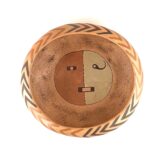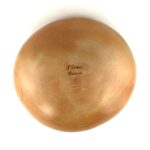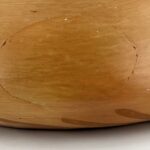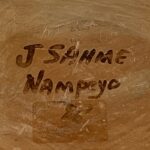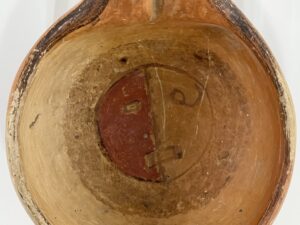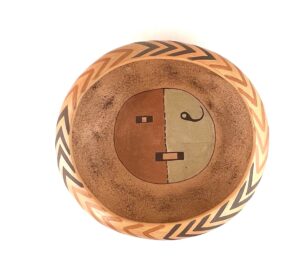The opening ranges from 8.5 to 9.1875 inches.
The design on this bowl is simple but striking. It is also ancient and persistent. The six sets of chevrons on the rim of bowl 2023-13 are unique in this collection, while the splattering of black dots on the interior is generally understood to represent rain and is a more frequent pottery motif (cf 2010-24). Multiple aspects of both the form and painting of this bowl indicate that it was made early in Jean’s pottery career. As such, it allows us to gage the development of her skills over time, culminating in her being named an “Arizona Living Treasure” in 2014.
Form:
The walls of this bowl are fairly substantial, thicker below the waist while the 1.5-inch-wide sloped surface above is thinner. The diameter of the mouth varies by 0.6875-inches and therefore is distinctly oval. Jean failed to remove an air bubble in one coil of her clay and this produced a 2.75-inch wide popout on the side of the bowl that Jean glued back into place after the firing. The surface fired a dark reddish tan, with some subtle blushing on the bottom. The bottom of the bowl is signed “Jean Sahme Nampeyo,” leaving out the “i” in Sahmie, as was her convention.
Design:
The interior of the bowl is lightly splattered with black paint. On the bottom of the interior Jean drew a 6-inch circle using black paint. She then vertically divided the circle with a dashed line. The left half of the circle was painted red, the right half a light turquoise blue. The left eye (viewer’s perspective) is a black rectangle with a central unpainted square as the iris. The right eye is a black tadpole-shaped figure with a long upward-curving tail. Below is placed a 1.75-inch-wide rectangular black mouth, its center a 0.875-inch-wide unpainted rectangle.
On the exterior sloped surface, between the jar’s rim and waist, Jean drew a parade of 29 black and red chevrons in groups of alternating color. The size of these groups is not regular: 4 black, 4 red, 4 black then 6 red, 6 black and finally 5 red.
Design Analysis:
The brush strokes needed to create this design are simple:
- 29 thick “V” shapes along the edge of the bowl,
- random splattering of black on the interior,
- a simple bifurcated circle, each half painted a different color,
- a rectangular mouth and two simple eyes
and the painting is complete.
While this is just speculation, this ease of design might have been an attraction to Jean near the beginning of her career.
Art historian Joseph Traugott discussed two bowls in an article about J. Walter Fewkes and Nampeyo (1999:17) and these bowls provide a history for this design. In 1896 Fewkes conducted an excavation of an ancestral Hopi site given the name of “Old Cunopavi.” One of the ancient objects found was a bowl featuring an image of Tawa, the Sun God. Apparently Nampeyo was inspired by the ancient pot and painted a variation of the design on a bowl that was purchased same year (1896) by the Smithsonian Museum.
- Ancient bowl from “Old Cunopavi.”
- Made by Nampeyo, 1896
As you can see, Nampeyo’s 1896 bowl was inspired by the ancient bowl but is not a direct copy. Ladle 2025-01 in this collection might also been made about 1896 and its design exactly matches the ancient bowl, as does Jean’s bowl, except for the change of one panel of color.
- Ladle 2025-01
- Jean’s bowl
On Jean’s bowl, the right eye (viewer’s perspective) is larger and its curve gives it more energy that the simple rectangle of the left eye. The mouth is off-center with the greater part on the right side of the dividing line. These inequalities give the right side of the Tawa image more weight than the left and energize the face. This same imbalance and energy is true for both the ancient jar and ladle 2025-01, pictured above. Jean was a careful observer.
Although the design is faithful to the ancient pot, Jean’s line work is heavy, especially compared with her later work (cf 1999-10). The walls of the bowl, particularly below the waist, are noticeable thick, allowing one section to “pop out” without penetrating to the interior. The ancient bowl Jean used as a model has an opening that is round, as near as I can tell from the drawing reproduced above. Given Jean’s faithful copy of the design, the oval form of the opening of her bowl might be inadvertent, though this is speculation on my part.
Gregory Schaaf, probably relying on information from Dick Howard, says Jean began making pottery in 1965 when she was about 17 years old. A variety of indicators suggest that bowl 2023-13 was made shortly after this date. The signature gives two indications: 1) Jean wrote “Nampeyo” as her last name, a convention often used by family members to attract sales early in their career. Once they get a reputation, skilled potters generally drop this appellation and simply use their given name. 2) Jean spelled out her name rather than the more familiar fish shaped “J” and corn symbol she used later (cf 2021-13). Moreover, 3) the pot’s thicker walls, off-round shape, pop out, simple design and heavy-handed line control, all suggest that this bowl was formed by a young potter still developing her skill.
To my eyes, these iregularities push this bowl into the category of “folk art,” a perspective I much admire. This image of Tawa is powerful and direct and thus the bowl has a commanding presence in spite of whatever imperfections might be indicated. However folk art was not the direction of Jean’s career as she continued to refine her ability to mold clay and developed increasingly detailed, sophisticated, designs. Jean was born in 1948 and passed in 2024.
Of the more than 600 pots in this collection, only two others cary the image of Tawa, the Creator (2017-07 and 2025-01).


